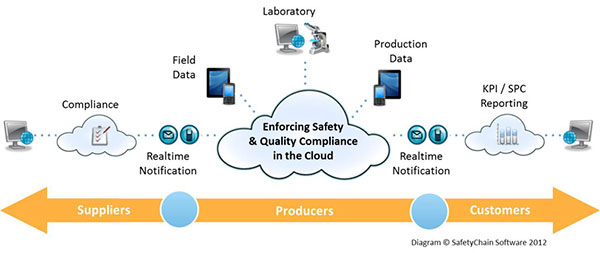Using ERP Systems for Food Safety
By Christian Hutter
One of the most significant recent trends in food safety is how food enterprises — from growers to manufacturers and distributors — will adjust to the stringent compliance requirements of the new U.S. Food Safety Modernization Act (FSMA). This legislation is poised to dramatically improve food safety, but it will also create many business and process challenges for food enterprises. FSMA shifts the focus in the food supply chain to preventing contamination, rather than simply responding to it. The emphasis is on prevention, accountability and responsibility for each step of the chain, all of which requires companies to develop, adhere to and monitor all their processes in preventing food contamination.
Meeting the Demands of FSMA
Going forward, companies will have to implement stepped-up controls, procedures, monitoring systems and paperwork within their operations. This can be a daunting undertaking for companies operating with multiple steps in their food production processes and running outdated legacy technology or manual systems. Legacy systems tend to be inefficient and prone to errors because of their inability to quickly find and produce the required data for audits, their limited ability to secure data and the lack of standardization capabilities that facilitate integration with other systems. That’s why the focus for many food enterprises in the next few years will be on implementing mobile technologies and new ERP (enterprise resource planning) systems for food safety that will facilitate compliance, enhance data quality and vastly improve food traceability for meeting new and stricter regulations.
Many food enterprises operate ERP and homegrown systems that are often 10 to 20 years old. These systems have not been kept up to date — even with periodic software patches — thus making them harder to support, driving up the cost of ownership and making it more challenging and costly to upgrade. They also create significant integration issues.
Food Safety ERP Integration is Key
Integration is critical to putting the right systems in place to promote food safety throughout a company’s operations. For example, a key step in complying with the stiff new food safety requirements is how well a food safety ERP system integrates with a company’s quality system. Companies that can’t integrate these systems are forced to go through a matching exercise, using spreadsheets to gather and analyze data from both systems. The increased documentation requirements of FSMA mean that these manual processes will prove not only costly but too time-consuming to meet regulators’ deadlines. Legacy systems also make it difficult to integrate more advanced technologies, like mobile, which can greatly improve transparency in the supply chain, enable field-to-fork traceability and empower the consumer with food safety information.
New ERP systems for food safety offer impressive scalability and performance, as well as food-specific functionality. Their advanced functionality and its lot trace capabilities can now deliver excellent traceability. And, by integrating ERP with mobile applications, companies also can code, track and trace their product items at the field level, processing facility or packing plant. As well, integrating ERP with new mobile traceability applications means that food enterprises can even communicate detailed food information — including product origin, expiration dates, packaging information, allergen facts, food recall information and marketing promotions — directly to the consumer at the point of sale.
Looking Ahead
We are moving into a period in which food enterprises must seriously evaluate their existing systems and processes to ensure that they not only directly address the complex and intensified documentation requirements of the FSMA, but also help improve quality and process efficiency and support future advances in food safety. Implementing new ERP systems for food safety that integrate seamlessly with a company’s quality system and other best-of-breed systems while supporting advanced applications, such as mobile, can provide both a cost-effective, one-step response to regulators’ records requests and an effective food safety solution for years to come.
About the Author
Christian Hutter is Junction Solutions’ Senior Vice President of Manufacturing and Distribution. Mr. Hutter also oversees the product and account management of the food and beverage, consumer packaged goods and life sciences industries practices at Junction Solutions.
To have more articles like this emailed to your inbox, become a GFSR Member today!

-
 FeaturedRisk management
The Cost of a Breach: What a Cyberattack Could Mean for Food Safety Recalls
FeaturedRisk management
The Cost of a Breach: What a Cyberattack Could Mean for Food Safety Recalls
-
 FeaturedRisk management
Securing the Food Chain: How ISO/IEC 27001 Strengthens Cybersecurity
FeaturedRisk management
Securing the Food Chain: How ISO/IEC 27001 Strengthens Cybersecurity
-
 FeaturedRisk management
Revolutionizing Food Safety Training: Breaking Out of the “Check-the-Box” Mentality
FeaturedRisk management
Revolutionizing Food Safety Training: Breaking Out of the “Check-the-Box” Mentality
-
 GFSI Standards
GFSI 2025: Building Trust, Tech-Forward Solutions, and Global Unity in Food Safety
GFSI Standards
GFSI 2025: Building Trust, Tech-Forward Solutions, and Global Unity in Food Safety
-
 FeaturedFood Safety
Integrated Pest Management: Strategies to Protect Your Brand’s Reputation
FeaturedFood Safety
Integrated Pest Management: Strategies to Protect Your Brand’s Reputation
-
 FeaturedFood Safety Culture & Training
No Open Door Policy: Challenges That Impact Pest Control in Food Processing Plants
FeaturedFood Safety Culture & Training
No Open Door Policy: Challenges That Impact Pest Control in Food Processing Plants



